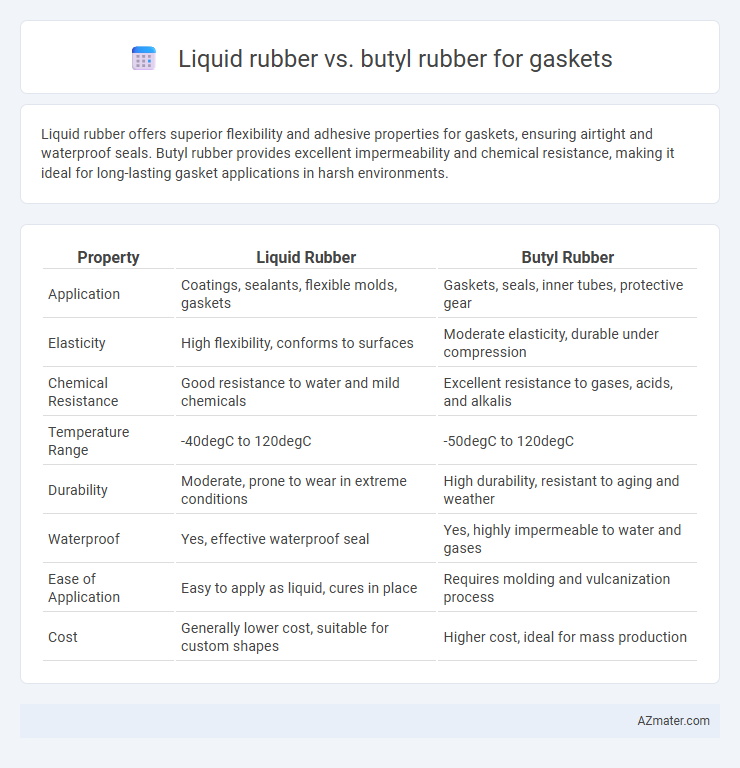Liquid rubber offers superior flexibility and adhesive properties for gaskets, ensuring airtight and waterproof seals. Butyl rubber provides excellent impermeability and chemical resistance, making it ideal for long-lasting gasket applications in harsh environments.
Table of Comparison
| Property | Liquid Rubber | Butyl Rubber |
|---|---|---|
| Application | Coatings, sealants, flexible molds, gaskets | Gaskets, seals, inner tubes, protective gear |
| Elasticity | High flexibility, conforms to surfaces | Moderate elasticity, durable under compression |
| Chemical Resistance | Good resistance to water and mild chemicals | Excellent resistance to gases, acids, and alkalis |
| Temperature Range | -40degC to 120degC | -50degC to 120degC |
| Durability | Moderate, prone to wear in extreme conditions | High durability, resistant to aging and weather |
| Waterproof | Yes, effective waterproof seal | Yes, highly impermeable to water and gases |
| Ease of Application | Easy to apply as liquid, cures in place | Requires molding and vulcanization process |
| Cost | Generally lower cost, suitable for custom shapes | Higher cost, ideal for mass production |
Introduction to Liquid Rubber and Butyl Rubber Gaskets
Liquid rubber gaskets offer exceptional flexibility and chemical resistance, making them ideal for dynamic sealing applications where adaptability to irregular surfaces is crucial. Butyl rubber gaskets provide superior impermeability and excellent resistance to air and moisture, commonly used in automotive and roofing industries for durable, airtight sealing. Both materials excel in gasketing but differ in application scope due to liquid rubber's conformability versus butyl's long-term sealing integrity.
Chemical Composition and Properties
Liquid rubber, primarily composed of synthetic polymers like polyurethane or nitrile butadiene, offers exceptional flexibility and chemical resistance, making it ideal for dynamic gasket applications. Butyl rubber, a copolymer of isobutylene and isoprene, excels in impermeability to gases and moisture, providing superior sealing and durability under harsh chemical environments. The distinct chemical compositions result in liquid rubber gaskets having enhanced elasticity and adhesion, while butyl rubber gaskets deliver outstanding resistance to aging, ozone, and weathering.
Durability and Longevity Comparison
Liquid rubber exhibits excellent flexibility and strong adhesion, offering superior resistance to weathering, UV exposure, and chemical degradation, which enhances gasket durability in dynamic environments. Butyl rubber is known for its exceptional impermeability and resistance to ozone and heat, providing long-lasting performance in static sealing applications exposed to harsh chemical and temperature conditions. Overall, liquid rubber gaskets excel in flexibility and rapid curing, while butyl rubber gaskets deliver unparalleled longevity in sealing integrity and environmental resistance.
Flexibility and Elasticity Differences
Liquid rubber offers superior flexibility compared to butyl rubber, adapting seamlessly to irregular gasket surfaces for enhanced sealing performance. Butyl rubber exhibits higher elasticity, allowing it to return to its original shape after compression and maintaining long-term durability in gasket applications. The choice between these materials depends on the need for conformability versus resilience in dynamic sealing environments.
Resistance to Chemicals and Solvents
Liquid rubber offers superior resistance to a broad spectrum of chemicals and solvents, including acids, alkalis, and hydrocarbons, making it ideal for gaskets in harsh chemical environments. Butyl rubber also provides excellent chemical resistance, particularly against polar solvents and gases, with strong impermeability to oxygen and water vapor. When selecting a gasket material, liquid rubber excels in applications requiring flexibility and chemical durability, while butyl rubber is preferred for long-term gas sealing and resistance to polar substances.
Temperature Tolerance and Performance
Liquid rubber offers superior flexibility and adheres well to irregular surfaces, maintaining performance across temperatures ranging from -40degC to 90degC. Butyl rubber gaskets excel in high-temperature resistance, tolerating continuous exposure up to 120degC and providing excellent impermeability to gases. For applications demanding resilience under fluctuating thermal conditions, butyl rubber generally outperforms liquid rubber in maintaining seal integrity and durability.
Installation and Maintenance Requirements
Liquid rubber offers superior ease of installation for gaskets due to its ability to form seamless, flexible coatings that conform to irregular surfaces, minimizing the need for precise measurements or cutting. Butyl rubber gaskets require careful fitting and occasional re-sealing to maintain their effectiveness, as they can lose elasticity and crack over time under stress or temperature fluctuations. Maintenance of liquid rubber gaskets typically involves less frequent inspections and repairs, as their chemical resistance and waterproof properties enhance durability in harsh environments.
Cost Factors and Economic Considerations
Liquid rubber offers lower initial application costs due to its ease of use and ability to form seamless seals without specialized equipment, making it suitable for small-scale or DIY gasket projects. Butyl rubber gaskets, although higher in upfront material and manufacturing costs, provide superior durability and chemical resistance, which can reduce long-term replacement expenses and maintenance needs. Evaluating the total cost of ownership involves balancing the higher immediate investment of butyl rubber against the potential savings from its extended service life and enhanced performance in demanding environments.
Environmental Impact and Safety
Liquid rubber offers a lower environmental impact compared to butyl rubber due to its water-based formula, reducing volatile organic compound (VOC) emissions during application and curing. Butyl rubber, derived from petroleum-based sources, has higher carbon emissions and slower biodegradability, posing greater long-term environmental concerns. In terms of safety, liquid rubber's non-toxic, odorless properties minimize respiratory hazards, whereas butyl rubber requires careful handling to avoid exposure to harmful chemicals during processing.
Best Applications for Liquid and Butyl Rubber Gaskets
Liquid rubber excels in creating seamless, flexible gaskets ideal for irregular surfaces and applications requiring excellent waterproofing, such as automotive seals and plumbing repairs. Butyl rubber offers superior airtightness and chemical resistance, making it best suited for HVAC systems, electrical insulation, and industrial gaskets exposed to harsh chemicals. Selecting between liquid and butyl rubber gaskets depends on whether flexibility and ease of application or chemical stability and durability are prioritized.

Infographic: Liquid rubber vs Butyl rubber for Gasket
 azmater.com
azmater.com